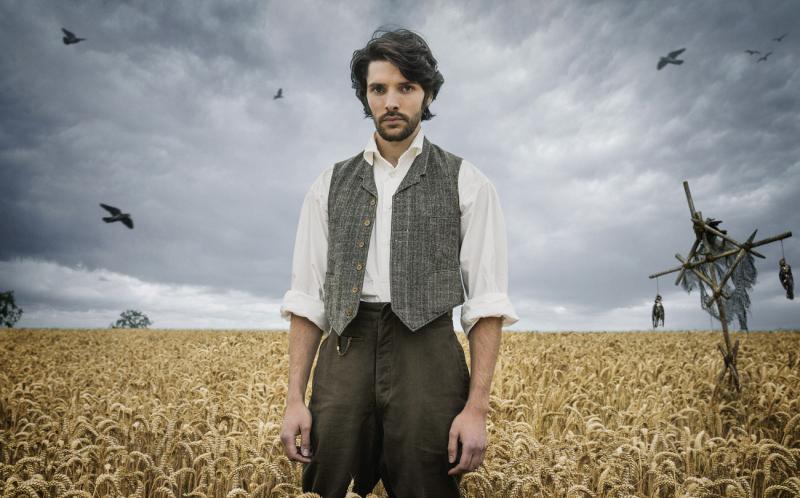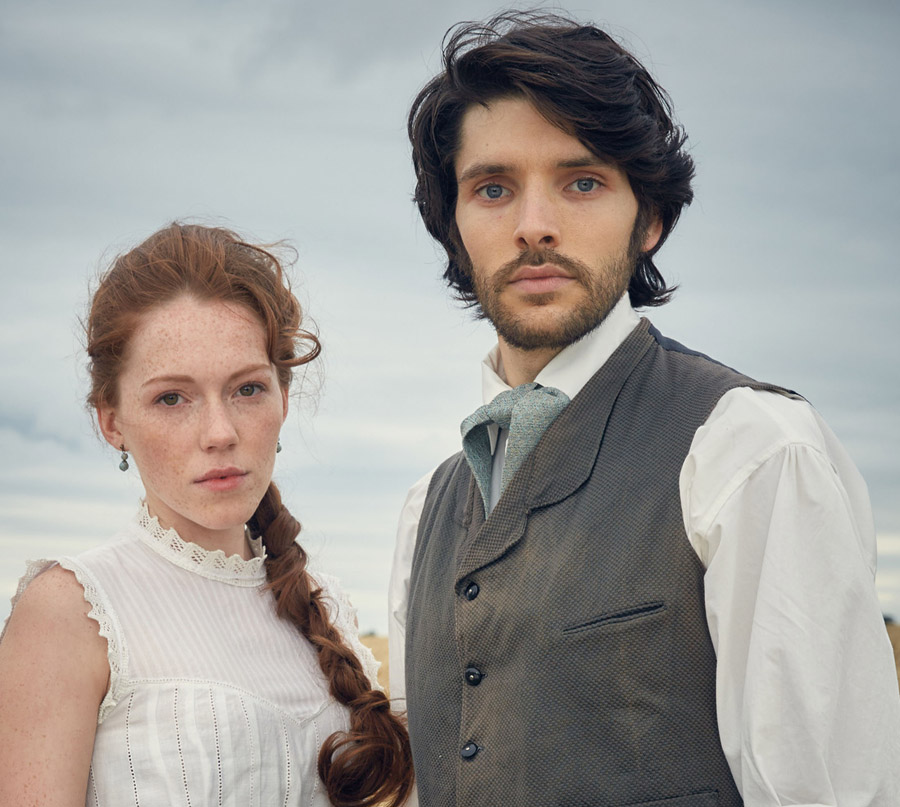The Living and the Dead, BBC One | reviews, news & interviews
The Living and the Dead, BBC One
The Living and the Dead, BBC One
Enlightenment battles superstition in this new historical chiller

This new series by Ashley Pharoah is dramatically different from his previous efforts in Ashes to Ashes and Life on Mars, though he still likes travelling though time. His method here was to saw off chunks of Far From the Madding Crowd, stir in some shavings from Henry James's The Turn of the Screw, and then, having donned protective clothing, to squirt in a distillation of The Exorcist.
The story so far: it's 1894, and Nathan Appleby (Colin Morgan), a man at the cutting edge of the new-fangled science of psychology, has returned to his family home in Shepzoy in Somerset, where his mother is seriously ill. At his side is his wife Charlotte (Charlotte Spencer, pictured below with Morgan), a frisky young thing who has been making a name for herself as a society photographer in London.
Shepzoy is a place where death walks behind you and the past is ever-present
By contrast to the modish concerns of the Metropolis – then, as now, a distant planet to further-flung parts of the country – the Appleby estate is an unspoiled time capsule where stoical and superstitious locals till the land, plough the fields, scythe the corn and then all go down the pub for a few pints of Old Muckspreader. Thanks to some expansive and atmospheric cinematography, which has been allotted plenty of space to capture glorious sunsets, crops rustling in the breeze and rolling acres of wood and field, the Somerset ambience is powerfully established.
When Nathan's mother dies, and he and Charlotte decide to leave London and try to make a go of running the financially challenged estate, ancient rural ritual and the eternal cycle of the seasons square up against cutting-edge notions of science and rationality. One of the first scenes we saw at the Appleby house was a ceremony to mark the Solstice, where the locals marched with lighted torches to ignite a giant bonfire, conjuring echoes of that pagan classic The Wicker Man. Out in the fields, they make scarecrows by hanging dead crows on a cross.
As night follows day, Nathan was soon reaching for his psychology textbooks to probe into the case of an adolescent girl, Harriet Denning (Tallulah Haddon), who was seemingly possessed by evil spirits. Or one particular evil spirit, that of a certain Abel North, remembered with a shudder by some of the farmhands. "He's in hell, if the Devil will have him," remarked old Gideon (Malcolm Storry). One recalled how, when drunk, he'd boasted of killing a girl from a local workhouse.
 The possession scenes were creepily effective, Harriet becoming positively toxic with menace as the vile North took control. More shocking, from Nathan's point of view, was the way she also mimicked the voice of his dead son Gabriel, whose lingering presence has haunted his father ever since his death by drowning. The discovery of some hidden wax cylinders containing crackly recordings of North's and Gabriel's voices helped to blur together primitive superstition with primitive, and perhaps unreliable, technology.
The possession scenes were creepily effective, Harriet becoming positively toxic with menace as the vile North took control. More shocking, from Nathan's point of view, was the way she also mimicked the voice of his dead son Gabriel, whose lingering presence has haunted his father ever since his death by drowning. The discovery of some hidden wax cylinders containing crackly recordings of North's and Gabriel's voices helped to blur together primitive superstition with primitive, and perhaps unreliable, technology.
Nathan, recently returned from a conference on psychological trauma in Vienna, lives by logic, reason and science, but evidently his empirical approach is going to be tested to its limits by a variety of sinister occurrences and apparitions throughout the six parts of The Living and the Dead. Shepzoy is a place where death walks behind you, and the past is ever-present. If you used to like those MR James ghost stories, this is one for you.
The future of Arts Journalism
You can stop theartsdesk.com closing!
We urgently need financing to survive. Our fundraising drive has thus far raised £49,000 but we need to reach £100,000 or we will be forced to close. Please contribute here: https://gofund.me/c3f6033d
And if you can forward this information to anyone who might assist, we’d be grateful.

Subscribe to theartsdesk.com
Thank you for continuing to read our work on theartsdesk.com. For unlimited access to every article in its entirety, including our archive of more than 15,000 pieces, we're asking for £5 per month or £40 per year. We feel it's a very good deal, and hope you do too.
To take a subscription now simply click here.
And if you're looking for that extra gift for a friend or family member, why not treat them to a theartsdesk.com gift subscription?
more TV
 Murder Before Evensong, Acorn TV review - death comes to the picturesque village of Champton
The Rev Richard Coles's sleuthing cleric hits the screen
Murder Before Evensong, Acorn TV review - death comes to the picturesque village of Champton
The Rev Richard Coles's sleuthing cleric hits the screen
 Black Rabbit, Netflix review - grime and punishment in New York City
Jude Law and Jason Bateman tread the thin line between love and hate
Black Rabbit, Netflix review - grime and punishment in New York City
Jude Law and Jason Bateman tread the thin line between love and hate
 The Hack, ITV review - plodding anatomy of twin UK scandals
Jack Thorne's skill can't disguise the bagginess of his double-headed material
The Hack, ITV review - plodding anatomy of twin UK scandals
Jack Thorne's skill can't disguise the bagginess of his double-headed material
 Slow Horses, Series 5, Apple TV+ review - terror, trauma and impeccable comic timing
Jackson Lamb's band of MI5 misfits continues to fascinate and amuse
Slow Horses, Series 5, Apple TV+ review - terror, trauma and impeccable comic timing
Jackson Lamb's band of MI5 misfits continues to fascinate and amuse
 Coldwater, ITV1 review - horror and black comedy in the Highlands
Superb cast lights up David Ireland's cunning thriller
Coldwater, ITV1 review - horror and black comedy in the Highlands
Superb cast lights up David Ireland's cunning thriller
 Blu-ray: The Sweeney - Series One
Influential and entertaining 1970s police drama, handsomely restored
Blu-ray: The Sweeney - Series One
Influential and entertaining 1970s police drama, handsomely restored
 I Fought the Law, ITVX review - how an 800-year-old law was challenged and changed
Sheridan Smith's raw performance dominates ITV's new docudrama about injustice
I Fought the Law, ITVX review - how an 800-year-old law was challenged and changed
Sheridan Smith's raw performance dominates ITV's new docudrama about injustice
 The Paper, Sky Max review - a spinoff of the US Office worth waiting 20 years for
Perfectly judged recycling of the original's key elements, with a star turn at its heart
The Paper, Sky Max review - a spinoff of the US Office worth waiting 20 years for
Perfectly judged recycling of the original's key elements, with a star turn at its heart
 The Guest, BBC One review - be careful what you wish for
A terrific Eve Myles stars in addictive Welsh mystery
The Guest, BBC One review - be careful what you wish for
A terrific Eve Myles stars in addictive Welsh mystery
 theartsdesk Q&A: Suranne Jones on 'Hostage', power pants and politics
The star and producer talks about taking on the role of Prime Minister, wearing high heels and living in the public eye
theartsdesk Q&A: Suranne Jones on 'Hostage', power pants and politics
The star and producer talks about taking on the role of Prime Minister, wearing high heels and living in the public eye
 King & Conqueror, BBC One review - not many kicks in 1066
Turgid medieval drama leaves viewers in the dark
King & Conqueror, BBC One review - not many kicks in 1066
Turgid medieval drama leaves viewers in the dark
 Hostage, Netflix review - entente not-too-cordiale
Suranne Jones and Julie Delpy cross swords in confused political drama
Hostage, Netflix review - entente not-too-cordiale
Suranne Jones and Julie Delpy cross swords in confused political drama

Add comment